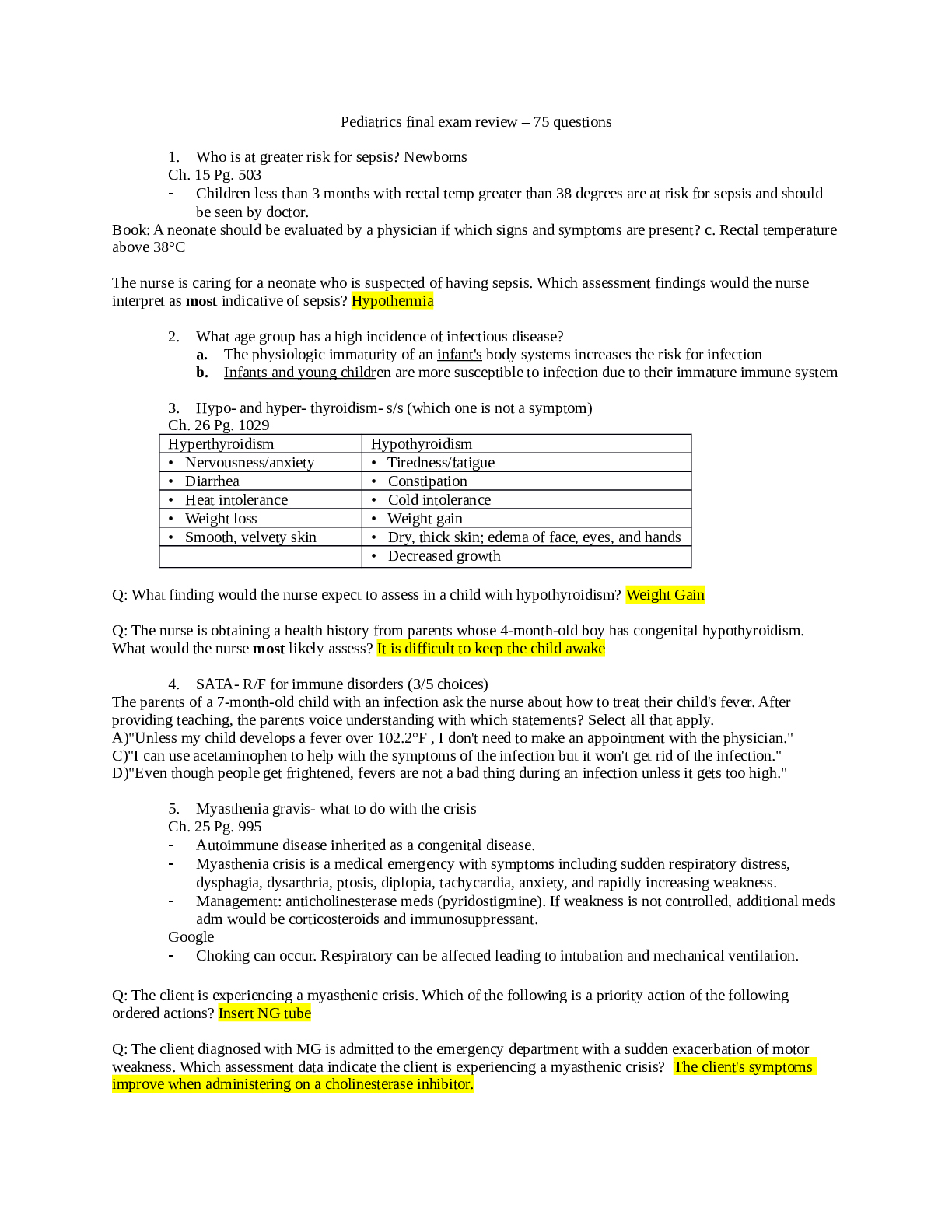1. Who is at greater risk for sepsis? Newborns
Ch. 15 Pg. 503
- Children less than 3 months with rectal temp greater than 38 degrees are at risk for sepsis and should
be seen by doctor.
Book: A neonate should be evaluated by a physician if which signs and symptoms are present? c. Rectal temperature
above 38°C
The nurse is caring for a neonate who is suspected of having sepsis. Which assessment findings would the nurse
interpret as most indicative of sepsis? Hypothermia
2. What age group has a high incidence of infectious disease?
a. The physiologic immaturity of an infant's body systems increases the risk for infection
b. Infants and young childr en are more susceptible to infection due to their immature immune system
3. Hypo- and hyper- thyroidism- s/s (which one is not a symptom)
Ch. 26 Pg. 1029
Hyperthyroidism Hypothyroidism
• Nervousness/anxiety • Tiredness/fatigue
• Diarrhea • Constipation
• Heat intolerance • Cold intolerance
• Weight loss • Weight gain
• Smooth, velvety skin • Dry, thick skin; edema of face, eyes, and hands
• Decreased growth
Q: What finding would the nurse expect to assess in a child with hypothyroidism? Weight Gain
Q: The nurse is obtaining a health history from parents whose 4-month-old boy has congenital hypothyroidism.
What would the nurse most likely assess? It is difficult to keep the child awake
4. SATA- R/F for immune disorders (3/5 choices)
The parents of a 7-month-old child with an infection ask the nurse about how to treat their child's fever. After
providing teaching, the parents voice understanding with which statements? Select all that apply.
A)"Unless my child develops a fever over 102.2°F , I don't need to make an appointment with the physician."
C)"I can use acetaminophen to help with the symptoms of the infection but it won't get rid of the infection."
D)"Even though people get frightened, fevers are not a bad thing during an infection unless it gets too high."
5. Myasthenia gravis- what to do with the crisis
Ch. 25 Pg. 995
- Autoimmune disease inherited as a congenital disease.
- Myasthenia crisis is a medical emergency with symptoms including sudden respiratory distress,
dysphagia, dysarthria, ptosis, diplopia, tachycardia, anxiety, and rapidly increasing weakness.
- Management: anticholinesterase meds (pyridostigmine). If weakness is not controlled, additional meds
adm would be corticosteroids and immunosuppressant.
Google
- Choking can occur. Respiratory can be affected leading to intubation and mechanical ventilation.
Q: The client is experiencing a myasthenic crisis. Which of the following is a priority action of the following
ordered actions? Insert NG tube
Q: The client diagnosed with MG is admitted to the emergency department with a sudden exacerbation of motor
weakness. Which assessment data indicate the client is experiencing a myasthenic crisis? The client's symptoms
improve when administering on a cholinesterase inhibitor.
6. HIV+ mother- what diagnostic test are you going to do?
Ch. 25 Pg. 982
- PCR test- positive in infected infants >1mo.
- ELISA- positive in infants with infected mother because of received antibodies
- CD4 counts are low in HIV infection
Book: A 4-month-old infant born to an HIV-infected mother is going into foster care because the mother is too ill to
care for the child. The foster mother wants to know if the infant is also infected. What is the best response by the
nurse? d. “The PCR test is positive; this indicates HIV infection, which may or may not progress to AIDS.”
7. Child in ER with pulse at 48- what indication are you going to give
- Atropine (anticholinergic): sinus bradycardia
- Dopamine (inotropic): bradycardia
- Epinephrine (vasopressor, inotropic): bradycardia
8. Asthma- dust in the air provokes attacks
Ch. 18
- Air pollution, allergens, family history, and viral infections might all play a role in asthma
Asthma in infants is usually triggered by: viral infection
9. Child who fell off a swing- what are you going to check after assessing ABC? The patient hit his head�LOC
Q: A child has fallen off of a swing at the playground and her father states that she became groggy. After assessing a
child's airway, breathing, and circulation (ABCs), what would the nurse do next? Assess level of consciousness
10. SATA- different respiratory infection in upper airway (2/5 choices) SEE HANDOUT
Ch. 29
- Burns
- Croup
- Epiglottitis
- Foreign-body aspiration
- Reflux
- Strangulation or near strangulation
- Tracheomalacia
- Vascular ring
Read More

